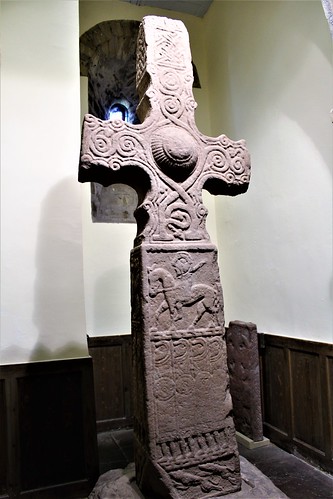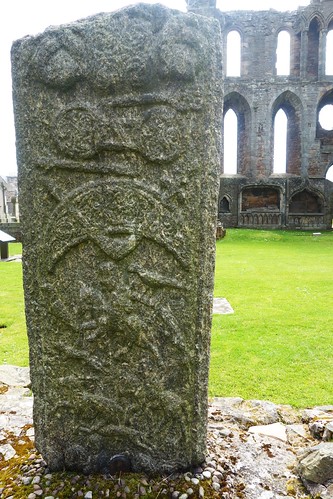The Picts
(Above image is a capture of a carved Pictish stone from Aberlemno in eastern Scotland.)
This evening, I am reporting on the Picts. These were the indigenous people of the land which is now called
Scotland. They were here before arrival of the Scots, Norse and Anglo-Saxons.The unique Pictish culture was subsumed within the combined Scottish-Pictish nation around the
ninth century AD.
Detail of carving at Meigle Museum in central Scotland.
The key means of connecting with the Picts is through their extensive legacy in the form of place names and elaborately carved stones, viz:
Pictish Place Names
Today, there are numerous Pet or Pit names which are usually reliable indicators of a Pictish origin. As the Picts settled the land first they selected well positioned, south facing sites for their settlements. Places with probable Pictish origins include Pitlochry, Pitagowan, Pitcairn, Pitmeddan, Pitroddie and Pittenweem. It is possible that the element Pent as found in Pentland Hills and Pentland Firth may also indicate a connection with the Picts. Using evidence from place name distribution and carved stones, it would appear that the Picts occupied the north and east of Scotland.
Pictish Carved Stones
The Irish named the Picts as the Cruithni or 'People of Designs'. In this regard the Picts have endowed us with a huge tangible legacy in the form of elaborate stone carvings, being a skill in which they clearly excelled. There are over 125 sites in Scotland where the stone carvings can be found or originated. Academics have divided the carvings in to three classes:
The Picts were keen hunters (principally targeting deer) and formidable warriors who were not afraid to take on the might of the Roman Army.
Today, there are many sites where the carvings can be viewed. In the county of Angus there is even a Pictish Trail, an itinerary which includes Pictavia Visitor Centre at Brechin, Brechin Cathedral and Round Tower, Aberlemno Sculptured Stones, Montrose Museum, St. Vigeans Museum, Dundee Museum, Meigle Museum (contains over 30 sculptured stones), Eassie Church, Kirremuir Museum, St. Orlands, Glamis, Glamis Manse and the Meffan which is a fine collection of stones at Forfar. Included in the wide range of other sites are the Dupplin Cross at Dunning, Dunfallandy Class 2 cross-slab near Pitlochry and at Dunrobin Castle.
The famous 9th century AD Dupplin Cross inside Dunning Church in central Scotland. The horseman in the centre of the upright is probably a Pictish king named Constantine.
Detail of King Constantine from above cross, Note huge head, which is indicative of status.
Carving of a cat at Meigle, central Scotland. the Picts had a special affinity with animals. The county of Caithness in the north of Scotland is named after this breed of felines.
Detail of carved stone at Abernethy, near Perth in central Scotland.
Heavily weathered carved stone at Elgin Cathedral, east of Inverness in the north of Scotland.
Elaborate carving on roadside at Aberlemno, eastern Scotland
The Picts have proved elusive in that they appear to have left no record of a discrete written language (although the elite may have understood Latin). The day-to-day language of the Picts may have been Brittonic and linked to modern-day Welsh.Whilst the Romans encountered the Picts, calling them Pictii or ‘Painted Men’, the Picts were never assimilated within the Roman Empire and hence we have only tantalising pieces of information from Roman sources. However, it appears that the massive Roman presence to the south did force what may have been a disparate group of tribes into a form of unity which prevailed through to the time of the Scots takeover.
Detail of carving at Meigle Museum in central Scotland.
The key means of connecting with the Picts is through their extensive legacy in the form of place names and elaborately carved stones, viz:
Pictish Place Names
Today, there are numerous Pet or Pit names which are usually reliable indicators of a Pictish origin. As the Picts settled the land first they selected well positioned, south facing sites for their settlements. Places with probable Pictish origins include Pitlochry, Pitagowan, Pitcairn, Pitmeddan, Pitroddie and Pittenweem. It is possible that the element Pent as found in Pentland Hills and Pentland Firth may also indicate a connection with the Picts. Using evidence from place name distribution and carved stones, it would appear that the Picts occupied the north and east of Scotland.
Pictish Carved Stones
The Irish named the Picts as the Cruithni or 'People of Designs'. In this regard the Picts have endowed us with a huge tangible legacy in the form of elaborate stone carvings, being a skill in which they clearly excelled. There are over 125 sites in Scotland where the stone carvings can be found or originated. Academics have divided the carvings in to three classes:
- Class 1, which are naturally occurring rocks or boulders containing groups of incised symbols and none of which carry Christian images which are recognisable today.
- Class 2, which are shaped and dressed and carry Christian symbols. These mainly comprise cross-slabs.
- Class 3, which are similar to Class 2 but carry no Class 1 symbols.
- Rods- v shape, z shape and straight.
- Objects-representations from everyday life which include items such as anvils, hammers, shears, mirrors and combs.
- Abstract Shapes- include arches, crescents, double crescents and discs.
- Animals-include boar, bull, goose, horse, strange beasts, salmon, snakes and stags.
The Picts were keen hunters (principally targeting deer) and formidable warriors who were not afraid to take on the might of the Roman Army.
Today, there are many sites where the carvings can be viewed. In the county of Angus there is even a Pictish Trail, an itinerary which includes Pictavia Visitor Centre at Brechin, Brechin Cathedral and Round Tower, Aberlemno Sculptured Stones, Montrose Museum, St. Vigeans Museum, Dundee Museum, Meigle Museum (contains over 30 sculptured stones), Eassie Church, Kirremuir Museum, St. Orlands, Glamis, Glamis Manse and the Meffan which is a fine collection of stones at Forfar. Included in the wide range of other sites are the Dupplin Cross at Dunning, Dunfallandy Class 2 cross-slab near Pitlochry and at Dunrobin Castle.
The famous 9th century AD Dupplin Cross inside Dunning Church in central Scotland. The horseman in the centre of the upright is probably a Pictish king named Constantine.
Detail of King Constantine from above cross, Note huge head, which is indicative of status.
Carving of a cat at Meigle, central Scotland. the Picts had a special affinity with animals. The county of Caithness in the north of Scotland is named after this breed of felines.
Detail of carved stone at Abernethy, near Perth in central Scotland.
Heavily weathered carved stone at Elgin Cathedral, east of Inverness in the north of Scotland.
Elaborate carving on roadside at Aberlemno, eastern Scotland










Comments
Post a Comment